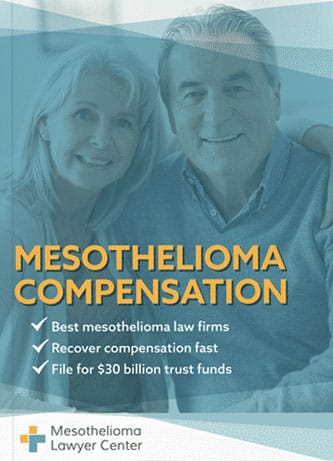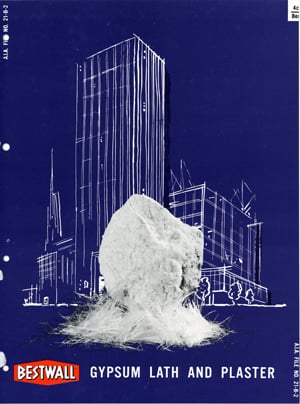Bestwall Gypsum was a manufacturer of building products, many of which contained asbestos. The company is still in operation today as part of Georgia-Pacific in Atlanta. Although the company no longer uses asbestos to make its products, Bestwall Gypsum exposed and harmed workers for decades.
If you or a loved one have mesothelioma, asbestos-related lung cancer, or asbestosis, you may be eligible for a large amount of compensation. FComplete nuestro formulario para obtener un Paquete de Compensación Financiera gratuito. Aprenderá sobre los abogados con experiencia en mesotelioma en su área, cómo recibir su pago en 90 días, cómo presentar una reclamación a los fondos fiduciarios de asbesto y más.


Paquete de compensación financiera GRATUITO
- Información sobre despachos de abogados que recuperarán su INDEMNIZACIÓN MÁS ALTA
- Aprenda cómo cobrar en 90 días
- Solicite su parte de $30 mil millones en fondos fiduciarios

Did Bestwall Gypsum Use Asbestos?
The construction industry used asbestos more heavily than almost any other. Hundreds of products that went into building homes contained asbestos in the mid-1900s.
Bestwall Gypsum was one of many companies that made construction materials and products with asbestos for decades. This put workers and homeowners at risk of asbestos exposure and illness.
Bestwall Gypsum History
Bestwall Gypsum was founded in 1961, but its origins began with Beaver Products’ Bestwall, a gypsum wallboard.
In 1928, CertainTeed Corporation bought Beavers Products’ Bestwall. At the time, CertainTeed Corporation was one of the largest distributors and manufacturers of gypsum-related products.
The company’s success continued growing throughout the 1950s, and stockholders created a spin-off named Bestwall Gypsum.
Along with gypsum products, the company added products to its line, including joint and spackling compounds.
In 1965, Georgia-Pacific, a paper product manufacturing company, purchased Bestwall Gypsum. At the time, both Georgia-Pacific and Bestwall continued to use asbestos in products and knew of its health dangers. It hid the information from consumers and workers.
In fact, Bestwall Gypsum continued asbestos use until the late 1970s, after the Environmental Protection Agency (EPA) placed strict regulations on its use.
Asbestos-Containing Products Manufactured by Bestwall Gypsum
Bestwall Gypsum manufactured numerous different types of asbestos-containing materials (ACMs).
The following ACMs were manufactured and sold by Bestwall Gypsum between 1950 through 1977:
- Drywall adhesive
- Kalite acoustical plaster
- Dry, triple-duty, and all-purpose joint compound
- Spackling compound
- Topping compound
- Bedding compound
- Texture compound
- Cemento
- Patching plaster
- Wet-mixed joint compound
Occupations Affected by Bestwall Gypsum Asbestos Products
Not only were Bestwall Gypsum employees placed at risk for life-threatening asbestos illnesses, but many workers in different companies worked with and around products that the company distributed.
The following occupations are among the many that were placed at direct risk because of Bestwall Gypsum:
- trabajadores de la construcción
- Instaladores de aislamiento
- Fontaneros
- Pintores
- Instaladores de paneles de yeso
- electricistas
- Home maintenance and repair workers
- Obreros
- trabajadores de demolición
Because Bestwall and other asbestos construction products linger in many older buildings, they continue to pose a risk. Residents and workers in older buildings are still at risk of exposure to Bestwall Gypsum asbestos products.
What Did Georgia-Pacific Know About Asbestos Dangers?
Many companies were found to have known about some of the dangers of asbestos exposure while failing to warn workers or remove products from the market. These include Georgia-Pacific.
A 2013 Center for Public Integrity report outlined how Georgia-Pacific funded a secret research program to disprove the connection between asbestos in its products and illness.
Georgia-Pacific funded this research as it began facing lawsuits over mesothelioma and other illnesses. The company paid scientists a total of $16 million to prove their joint compound and other products didn’t cause harm.
Bestwall Gypsum Mesothelioma Lawsuits
During the 1980s, the first signs of illness began to surface in many of Bestwall Gypsum’s former employees.
Customers were also being diagnosed with enfermedades relacionadas con el amianto, which were traced back to the use of both Bestwall Gypsum and Georgia-Pacific’s products. Former employees and consumers began filing asbestos and mesothelioma lawsuits.
Former television star and NFL football player Merlin Olsen was diagnosed with malignant mesothelioma in 2009.
After in-depth investigations, his abogado de asbesto discovered that Olsen was exposed to asbestos while working as a broadcaster for NBC, which used Bestwall Gypsum products.
While working at age 11, Olsen was also exposed to asbestos when performing general maintenance duties for a Bestwall Gypsum product company.
In 2010, Olsen died of complications surrounding malignant mesothelioma. His wife, June Olsen, pursued a lawsuit on his behalf against Georgia-Pacific, CertainTeed Corporation (in connection with Bestwall Gypsum), and numerous other companies.
Although NBC was eventually dropped from the lawsuit in 2011, the lawsuit was settled for an undisclosed amount by the remaining companies, including Georgia-Pacific.
By 2005, Georgia-Pacific had already faced over 300,000 asbestos-related claims, equaling a total of $830 million.
Bestwall Bankruptcy and Asbestos Claims
Georgia-Pacific was the first company to use a controversial legal maneuver known as the ‘Texas Two-Step’ to avoid or minimize asbestos liabilities. Step one of the move was to spin off a subsidiary called Bestwall and headquarter it in Texas. G-P moved all of its asbestos liabilities to Bestwall.
In step two, Bestwall filed for bankruptcy in North Carolina, a state often favorable to asbestos companies. The bankruptcy protects the company’s assets from asbestos lawsuits. The parent company, Georgia-Pacific, then commits funds to an asbestos trust fund to compensate claimants.
G-P began this maneuver in 2017, which has been controversial and tied up in courts ever since. As part of the bankruptcy, Georgia-Pacific pledged $1 billion for an asbestos trust fund.
Asbestos victims and their lawyers have fought against Georgia-Pacific’s move, claiming it unfairly limits the victims’ rights to seek compensation. The most recent court decision, from June 2023, went in favor of Georgia-Pacific, extending a stay on asbestos lawsuits.
What to Do if You Were Exposed to Bestwall Gypsum Asbestos Products
The current legal situation involving Georgia-Pacific and Bestwall makes it difficult for asbestos victims to get the compensation they deserve.
Contact a mesothelioma lawyer to learn about any alternative options you might have. Most people with asbestos illnesses were exposed to asbestos by multiple companies. You could be entitled to presentar una demanda against other defendants. You might also be eligible for one or more fondos fiduciarios de amianto.
Additional Information and Legal Resources
Remember, if you’ve been diagnosed with mesothelioma, asbestos-related lung cancer, or asbestosis, you may qualify for significant compensation. No olvides rellenar nuestro formulario para obtener nuestro regalo gratis. Paquete de compensación financiera, lleno de información sobre los abogados con experiencia en asbesto y mesotelioma en su área.
Asbestos in Sheetrock and Insulation: What You Need to Know Before Renovating
Many homes built or renovated before the 1980s still contain asbestos—especially in materials like sheetrock (drywall) and insulation. In this video, David Foster explains how these once-common building materials can pose serious health risks when disturbed during remodeling or demolition.
You’ll learn how asbestos fibers become airborne, why even small-scale renovations can be dangerous, and why professional inspection and testing should be your first step. Whether you’re a homeowner or contractor, knowing where asbestos hides—and how to handle it safely—can help prevent life-threatening exposure.

Pablo Danziger
Revisor y editorPaul Danziger creció en Houston, Texas, y se licenció en Derecho en la Facultad de Derecho de la Universidad Northwestern en Chicago. Durante más de 25 años, se ha dedicado a representar a víctimas de mesotelioma y a otras personas afectadas por la exposición al asbesto. Paul y su bufete han representado a miles de personas diagnosticadas con mesotelioma, asbestosis y cáncer de pulmón, obteniendo indemnizaciones significativas para los clientes lesionados. Cada cliente es fundamental para Paul y atenderá todas las llamadas de quienes deseen hablar con él. Paul y su bufete se encargan de casos de mesotelioma en todo Estados Unidos.
Conéctese con el abogado especializado en mesotelioma Paul Danziger
Referencias
- Cision PR Newswire. (2017, November 2). Bestwall LLC, a Georgia-Pacific Affiliate, Takes Action to Achieve Equitable and Permanent Resolution of Asbestos Claims.
Recuperado de: https://www.prnewswire.com/news-releases/bestwall-llc-a-georgia-pacific-affiliate-takes-action-to-achieve-equitable-and-permanent-resolution-of-asbestos-claims-300548341.html - Dixon, L., McGovern, G., and Coombe, A. (2010). Asbestos Bankruptcy Trusts. An Overview of Trust Structure and Activity with Detailed Reports on the Largest Trusts.
Recuperado de: http://www.rand.org/content/dam/rand/pubs/technical_reports/2010/RAND_TR872.pdf - Knauth, D. (2023, June 20). Georgia-Pacific May Maintain Bankruptcy Pause on Lawsuits, Court Rules. Reuters.
Recuperado de: https://www.reuters.com/legal/georgia-pacific-may-maintain-bankruptcy-pause-lawsuits-court-rules-2023-06-20/ - Morris, J. (2013, October 21). Facing Lawsuits Over Deadly Asbestos, Paper Giant Launched Secretive Research Program. The Center for Public Integrity.
Recuperado de: https://publicintegrity.org/environment/facing-lawsuits-over-deadly-asbestos-paper-giant-launched-secretive-research-program/
